Беденко С.В.1, Губайдулин И.М.2, Кнышев В.В.2, Плевако М.Н.2
1Доцент; 2студент, Национальный исследовательский Томский политехнический университет
ОПТИМИЗАЦИЯ НЕЙТРОННО-ФИЗИЧЕСКИХ ХАРАКТЕРИСТИК СИСТЕМ «СУХОГО» ХРАНЕНИЯ ОТРАБОТАВШЕГО ТОПЛИВА УРАН-ГРАФИТОВЫХ РЕАКТОРОВ КАНАЛЬНОГО ТИПА
Аннотация
Проведены расчетные исследования нейтронно-физических характеристик систем «сухого» хранения отработавшего топлива уран-графитового реактора. Оптимизированы параметры систем и схем обращения в процессе «сухого» хранения отработавшего ядерного топлива за счет чередующегося размещения его слоев с различной глубиной выгорания и обогащения.
Ключевые слова: «Сухое» хранение, отработавшее ядерное топливо, эффективный коэффициент размножения нейтронов.
Bedenko S.V. 1, Gubaydulin I.M.2, Knyshev V.V.2, Plevako M.N.2
1Docent; 2student, National Research Tomsk Polytechnic University
OPTIMIZATION OF NEUTRON-PHYSICAL CHARACTERISTICS OF «DRY» STORAGE SYSTEMS OF SPENT NUCLEAR FUEL OF URANIUM-GRAPHITE PRESSURE TUBE REACTORS
Abstract
Computational studies of the neutron-physical characteristics of the systems of «dry» storage of spent nuclear fuel of the uranium-graphite reactors have been carried out. A range of practical recommendations for the optimization of the parameters of the systems and schemes of handling and placement of spent fuel in a «dry» storage have been developed.
Keywords: «dry» storage system, spent nuclear fuel, effective neutron multiplication factor.
The state of research
The pace of development of nuclear power industry is largely determined by external components of the nuclear fuel cycle and by the long-term storage of spent nuclear fuel (SNF) and its processing in particular.
Storages of spent nuclear fuel of the RBMK-1000, VVER-440, 1000, BN-600, EGP-6 were designed in the 1960s−1970s. In recent years, while both the actual change in the concept of a closed fuel cycle and safety requirements have changed, it became necessary to seal the fuel storage and increase the capacity of existing storage facilities. This is primarily due to the increase of SNF from RBMK and VVER, as the fuel of the RBMK, VVER, EGP is not processed and is stored by the «wet» method in the intermediate-storage pools at nuclear power plants, which are close to overfill. For the solution of this problem there is a need for the commissioning of some additional capacity for a long-term storage (50 years or more) of spent nuclear fuel [1−3].
After the decay of a significant amount of short-lived radio nuclides in the pre-exposure of spent nuclear fuel in water for the reduction of the heat and radioactivity emission, it appears advisable to switch to the «dry» method of storing spent nuclear fuel. Therefore, diverse research and scientific and technological development for the creation of the conditions for long-term “dry” storage of spent fuel are of a great practical interest.
The purpose of this research is scientifically rational and practical recommendations for creating a technology to optimize the neutron-physical parameters of the systems and schemes of placing spent fuel in the «dry» storage. Achievement of the stated goal leads to a better efficiency and safety of the “dry” storage of spent nuclear fuel (SKHOYAT).
Nowadays the fuel of RBMK is initially stored underwater in near-reactor pools, then in the long-term storage. Considering the state of the covers, which defines the period of storage of spent fuel assemblies (SFA) in water for 30 years, there is a need to move to a «dry» storage. The world experience of designing of the «dry» storage allows us to predict the level of nuclear safety which is much higher than in pools of water, which is achieved by the design of tight and hermetic storage places and storage penals, capable of withstanding a variety of designed and beyond-designed basis accidents, and by the absence of neutron moderators in storage cameras and penals.
In recent days, a common problem for all stores is the evidence of nuclear safety during the transition to the uranium-erbium fuel enriched to 3% of 235U [3, 4]. To substantiate the safety of the nuclear spent fuel storage systems the following programs are used implementing the Monte-Carlo method: MCU-RFFI, MCNP, SCALE, MMKFK-2, allowing to calculate the effective coefficient (keff) of storage, accurate within ~ 10−4 − 10−5.
With the advent of a new type of fuel – uranium-erbium fuel for RBMK reactors, uranium-gadolinium for the VVER reactors, mixed oxide (U,Pu)O2, nitride (U,Pu)N, carbide (U,Pu)C for the BN-600, in the long term for the VVER it is necessary to justify the safety of existing storage systems.
Algorithm of calculation
The calculation was performed using the software package SCALE 5.0. SCALE is an internationally recognized program which is based on the implementation of the Monte-Carlo method. This software package allows the calculation of neutron-physical parameters of the storage and transportation containers, with fresh and irradiated nuclear fuel, the calculation of the isotopic composition of spent nuclear fuel.
The decision to carry out computational studies fell on the analytical sequence CSAS25, which automatically handles the cross-section, and then it simulates physical weight of the technical system depending on the initial and boundary conditions expected.
This analytical sequence allows calculations of keff for the three-dimensional problems. For this purpose the values of isotopic composition of fuel or several fuels is given to software package SCALE 5.0, as well as compositions of other materials used in the following description of the model. Depending on the task, analytical sequence and library sections are selected. In the calculations the 27-group library of cross sections was used, which was obtained from the convolution of the 218-group library based on the library data ENDF/B-IV. The choice of the library is most optimal for the criticality of calculations.
Then the geometry was described. The package of applied programs SCALE 5.0 used cell modeling method, which greatly simplifies the calculation of the neutron-physical parameters for this problem. For this purpose the geometry of a single cell is described, and then, the field, which is an array of 22×11 cells is set. A more detailed computational model is described in the next section.
The module CSAS25 runs consistently functional modules BONAMI, NITAWL-II and KENO V.a. to handle the required cross sections and calculate the keff of «dry» storage system.
Simulated model of the «dry» storage system camera span of 12m
Storage of spent fuel in Russia is provided in special slots, where the hermetic containers with spent fuel are placed. Each camera has 242 storage slots of hermetic containers with spent fuel of RBMK, located in the slot in two levels. About 3,503 tons (of uranium) of spent nuclear fuel of RBMK (or 2,4 tons of spent nuclear fuel of VVER) is located in each slot.
The slots are placed in a square lattice with a pitch of 1000 mm (the diameter of the slot 720 mm, thickness 7 mm). Canister (container) is a steel pipe with the size of 630 × 7 mm, length 4.1 m and the case is made from steel 10ChSND. Each pencil case has 31 ampoules with RBMK spent fuel assemblies (see Figure 1). Diameter of ampoules 92×2 mm, which are located at the distance of 96 mm from each other in a triangular lattice. Containers are placed in slots in two tiers, one above another.
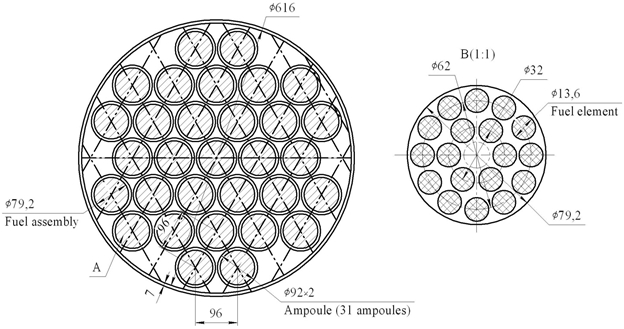
Fig. 1 – Distribution scheme of ampoules with RBMK-1000 spent fuel assemblies in the case: B – distribution scheme of fuel elements in fuel assemblies
Each slot of simulated models with canisters placed is a unit, to calculate the values of keff of simulates model is approximated as possible to the real storage system as much.
To describe one cell of «dry» storage in SCALE 5.0 an equivalent cell was created, called a UNIT. An array with the size of 22 × 11 units was formed from this UNIT, which is processed by the program. The example of filling of array by UNITs is given in fig. 2.
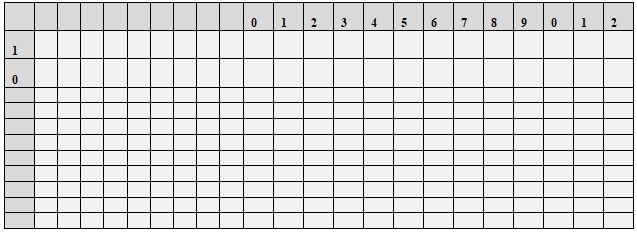
Fig. 2 – The array in the size 22×11, consisting of one type of UNIT
Additionally, the following approximations were made:
- Fuel in canisters is «fresh» (design accident).
- Analysis of nuclear safety for the beyond-design-basis accidents were made in view of burnup.
- From the main fission products only Sm149 is considered, secondary fission products are not considered.
- The main sources of spontaneous neutrons are isotopes of Pu, Am and Cm.
- The main sources of (α,n)-neutrons are the following dioxides: Pu238O2, Am241O2, Cm242O2 and Cm244O2.
- The system is a nuclear-safe only if keff ≤ 0,85.
The results of calculations of keff of the «dry» storage system of RBMK spent nuclear fuel of camera span of 12 m
The case of «fresh» fuel. The variants of design (fillings of the storage system with water, but water is absent in the canisters with ampoules) and beyond-design-basis accidents (filling of the storage system and all the ampoules with water, which are located in canisters).
Uranium fuel with enrichment of 1.6, 2.0, 2.4, 2.6 and 2.8% was used in the calculation of keff of «dry» storage system.
Results of the calculation of keff for fuel with initial enrichment of 1.6% for five different downloads:
- In the «dry» storage system was one slot with canister placed in the center. keff = 0,1252 ± 0,0004.
- The «dry» storage system is completely filled with the fuel. keff = 0,2829 ± 0,0008.
- In «dry» storage system was one slot with penal placed in the center. The «dry» storage system completely filled with water, water was everywhere except the slot with canisters. keff = 0,3572 ± 0,0010.
- The «dry» storage system completely filled with the fuel. The «dry» storage system completely filled with water, water was everywhere, but slots with canisters are not filled with water. keff = 0,3867 ± 0,0009.
- The «dry» storage system is completely filled with the fuel. We consider a beyond-design-basis accident, water filling the storage and all ampoules, which are located in canisters in the slot of the store. keff = 0,8146 ± 0,0014.
Results of calculation of keff for fuel with another enrichment are given in the table 1. Numerals 1, 2, 3, 4 and 5 correspond to the downloads schemes, which are given above.
Table 1 – The calculated values of keff of the «dry» storage system with different fuel enrichment
| Enrichment, % | 1 | 2 | 3 | 4 | 5 |
| 1,6 | 0,1252
±0,0004 |
0,2829
±0,0008 |
0,3572
±0,0010 |
0,3867
±0,0009 |
0,8146
±0,0014 |
| 2,0 | 0,1299
±0,0004 |
0,3034
±0,0006 |
0,3779
±0,0010 |
0,4108
±0,0011 |
0,8942
±0,0014 |
| 2,4 | 0,1338
±0,0004 |
0,3277
±0,0007 |
0,4003
±0,0011 |
0,4319
±0,0013 |
0,9502
±0,0015 |
| 2,6 | 0,1355
±0,0004 |
0,3399
±0,0008 |
0,4058
±0,0012 |
0,4422
±0,0012 |
0,9756
±0,0017 |
| 2,8 | 0,1362
±0,0004 |
0,3499
±0,0008 |
0,4115
±0,0012 |
0,4492
±0,0011 |
0,9967
±0,0014 |
Thus, the emergence of self-sustaining fission reaction is possible for the fuel with the enrichment of 2.6% and 2.8%, and only in case of beyond-design-basis accident, when there is a filling of the storage and some of its parts with water. However, this event is impossible. In addition, in accordance with PNAE-G-14-029-91 [4], nuclear safety beyond-design-basis accidents should be justified in view of measure of burnup of spent nuclear fuel, as a really stored burnt fuel.
The case of «burned» fuel. The «dry» storage system completely filled with RBMK-1000 spent nuclear fuel (enrichment − 2%, burnout – 19 740 MW∙day/ton, confinement time – 180 days and 10 years). The neutron source (n/(s∙ton)) was calculated according to [2, 5−7], the calculation method is presented in [6].
Effective multiplication factor of the «dry» storage system loaded by RBMK-1000 spent nuclear fuel is equal to keff = 0,2229 ± 0,0005. The values of the neutron flux as a function of UNIT location in the array are presented below graphically in Fig. 2.1 and 2.2.
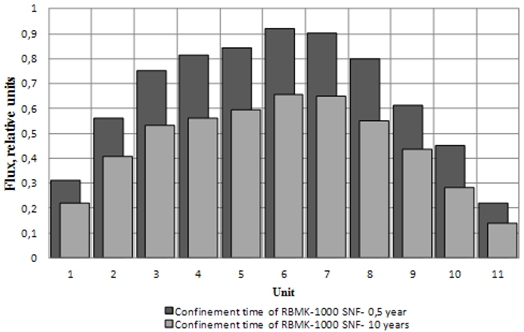
Fig. 2.1 – The value of fast neutrons, depending on UNIT location in the array

Fig. 2.2 – The value of fast neutrons, depending on UNIT location in the array
Calculations showed that burn-up will reduce the value of keff for 32% and as a result from the viewpoint of nuclear safety camera span 12 m of the «dry» storage system is deep subcritical system even in case of beyond-design-basis accidents, but level of neutron radiation at a fuel with burn-up of 19 740 MW∙day/ton is greater than the maximum permissible value.
Thus, it is vital to optimize the distribution scheme in the dry storage system of spent nuclear fuel with different burn-up in order to reduce radiation exposure to personnel.
One of the variant of filling is given below (see Figure 3) It allowed to reduce the levels of neutron radiation at certain points of the storage system to limit values [4].
Effective multiplication factor of the «dry» storage system (see the array shown in Figure 3) is equal to keff = 0,2148 ± 0,0003. Fluxes of the modeled system, depending on location in the array UNIT below (see Figure 3.1 and 3.2).
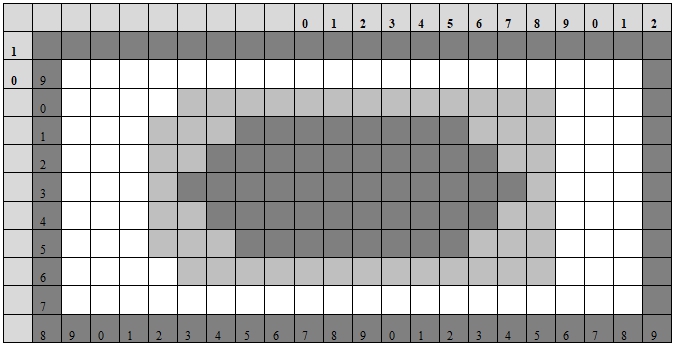
Fig. 3 – An array of size 22 × 11.
UNIT 1−slot with canisters, burning 19740 MW∙day/ton;
UNIT 2 – slot with canisters, burning 24910 MW∙day/ton;
UNIT 3 − slot with canisters, burning 29285 MW∙day/ton;
UNIT 5, 39 … 69 − the empty slots
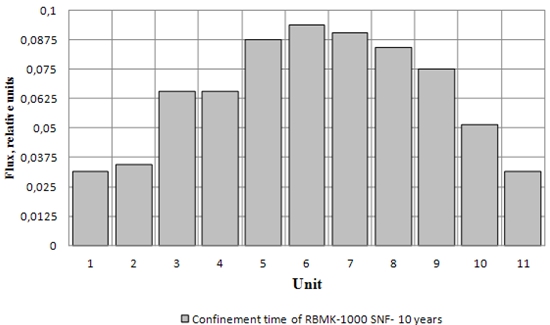
Fig. 3.1 – The value of fast neutrons, depending on UNIT location in the array

Fig. 3.2 – The value of fast neutrons, depending on UNIT location in the array
Conclusion
- It was found that under proper operation and design-basis accidents the «dry» storage system of spent nuclear fuel is deeply subcritical system (scheme of loading – 1 − 4, see Table 1.), with keff ≤ 0,45.
- It was found that the considering of burn-up would reduce the value of keff for ~ 32%, and the «dry» storage system of spent nuclear fuel would be deeply subcritical system even in case of beyond-design-basis accidents, but levels of neutron radiation with a burn-up of 19 740 MW∙day/ton exceed the maximum permissible value.
- Thus, it is necessary to optimize distribution scheme of spent nuclear fuel with different burn-up in dry storage system to reduce radiation exposure on personnel.
- Variant of «downloading» of the «dry» storage system suggested in the researching work (see Figure 3.) will reduce the radiation levels at certain points in the storage to the maximum permissible values.
References
- N. Nesterov, Providing design value nuclear fuel burnup of high-temperature gas-cooled reactor by operability graphite // News of high school. Nuclear power. – 2013 – №. 2 . – P. 133-142.
- V. Bedenko, Features of radiation field of irradiated ceramic nuclear fuel. Neutron radiation of irradiated nuclear fuel. – Saarbrucken: LAP LAMBERT Academic Publishing GmbH & Co. KG, 2012.
- V. Shamanin, S.V. Bedenko, I.M. Gubaydulin, Threshold reactions and limit of burnup of irradiated ceramic nuclear fuel // News of high school. Physics. – 2014 – T. 57 – №. 2/2. – P. 8-12.
- V. Shamanin, S.V. Bedenko, I.M. Gubaydulin, Operational features of technical systems «dry» storage of spent nuclear fuel // News of high school. Physics. – 2013 – T. 56 – №. 4/2. – P. 343-349.
- V. Shamanin, S.V. Bedenko, I.M. Gubaydulin, Operational features of technical systems «dry» storage of spent nuclear fuel//News of the universities. Physics. – 2013 – T. 56 – №. 4/2. – P. 343-349.
- V. Bedenko, I.V. Shamanin «Neutron activity of the spent ceramic nuclear fuel»//News of high schools. Physics. – 2011. – Т. 54. – № 11/2. – P. 51–56.
- V. Shamanin, P.M. Gavrilov, S.V. Bedenko, V.V. Martynov, Optimization of neutron- physical characteristics of spent fuel storage // News of TPU. – 2012 – T. 320 – №. 4 – P. 10-14.






